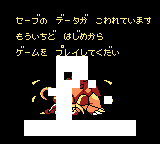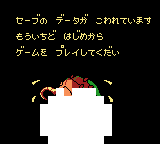Pokémon Diamond and Jade
- Pokémon Diamond redirects here. For the Pokémon game by Game Freak, see Pokémon Diamond and Pearl on Wikipedia.

|
This article needs to be cleaned up. Reason: There are various scans of the instruction manual, pictures of cartridges, and alternate boxarts that might be notable to include in this article. You can help Wikifang by improving this article. See here for a full list of articles waiting to be cleaned up. |
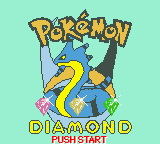
Pokémon Diamond and Jade are bootlegged versions of Keitai Denjuu Telefang 1. The Power Version was used to make Diamond, and the Speed Version became Jade. Along with a Chinese version, partly-translated German and Spanish versions also exist. Pokémon Jade has also been used for the name for an edited version of a pirated game called Sonic Adventures 7.
Boxarts[edit]
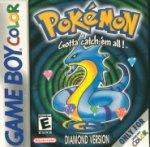
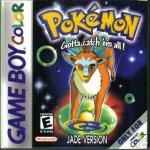
The monsters on the boxarts of Pokémon Diamond and Jade are neither Denjuu nor Pokemon. Pokémon Diamond features a blue snake-like creature of unknown origin, while Jade has a modified design of the forest spirit from the film Princess Mononoke. The backs of most boxes are closely copied from the legitimate Pokémon Gold and Silver games, with screenshots having been edited to include the fake mascot monsters, sometimes with monsters from other series such as Dragon Quest also included in the box design. There are many different variations of these boxes for different copies of the game, though this is typical of pirated games.[1]
Cartridges[edit]
For both Pokémon Diamond and Pokémon Jade, the cartridges are unlike legitimate Game Boy cartridges, and like the boxes, different variations of these cartridges exist.[1] [2] Most of the art on the cartridges are taken from the boxes of their respective games. Also, one type of Diamond cartridge has a nonstandard white casing, and Jade has a nonstandard green translucent casing. There are other Jade cartridges with black casings, just like other Game Boy Color games that are compatible with the original Game Boy. Also, like other bootleg cartridges, some of these cartridges say either "GAME", "GAME COLOR" or nothing at all on the top instead of the usual "Nintendo GAME BOY™" that is on authentic cartridges. They might also use a different, simpler type of screw on the back than those found on authentic cartridges.
Sometimes, either Diamond or Jade is bundled with a pirated Pokémon Crystal, which, like Diamond and Jade, is unofficially and poorly translated from the Japanese version (most likely before Crystal was released outside of Japan), and has glitches not present in the original version. Also, some cartridges have both Diamond and Jade in one.
Translation[edit]
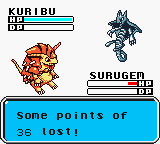
The translation has a reputation of being filled with Engrish, although said Engrish is usually comprehensible. Nearly all the characters' names are changed. The names given to the Denjuu in these translations are based on non-romanized versions of their original names, names of plants related to their original namesakes, or random nouns. Crypto (romanized from Kuriputo) becomes Kuribute, Hagumanoki becomes Sumac (a plant related to the Denjuu’s namesake) and Easydog becomes Hat (random noun). T-Fanger, a term for people who use Denjuu, becomes T-Mildew (through the romanization T-Fangaa, which sounds like T-Fungus). Another notable characteristic of this translation is the presence of swear words.
Evidence suggests that the game was translated from Japanese to Chinese first, and then from Chinese to English, retaining various errors originating from the Chinese translation.[3] However, the Chinese release features Denjuu names unlike the English or Japanese games, implying that rather than a "chain translation", the English and Chinese translations were developed in parallel, by the same pirates. For example, Kanzou is named 抢像 (qiāngxiàng), which is difficult to impossible to translate to Lily; additionally, because of a two-character limit, numerous details from the Japanese names were lost, while the English names retain them. Thus, it is reasonable to infer that the translations were made at the same time.
Changes[edit]
Besides translating the game, a few other changes were made. The most notable was the removal of the ability to name the protagonist as well as the ability to nickname any Denjuu that the player befriends. The protagonist is always named "Bek", and all befriended Denjuu are automatically nicknamed to shortened forms of their species' names. This change was made likely because the name input was designed to work with Japanese characters, as opposed to the Latin alphabet, and the bootleggers did not know how to edit the characters for the name input.
Personalities and statuses often have nonsensical text, or are blank. This is because the original games use an 8-character limit for personalities and a 4-character limit for statuses, but the bootlegs act as if there is a 16-character limit for each.
Another change was that the real time clock was removed probably to save money. When an emulator is paused, sped up, or slowed down, the clock will pause, speed up or slow down as well. The clock will also stop when the game is switched off. In the original games, the clock always runs at a constant speed regardless of an emulator or gaming device. Each second in the original games passes after every 60 frames, whereas each second in the bootlegs passes after every 50 frames instead, which means the clock runs faster in Diamond/Jade than in Power/Speed.
The Smilesoft, Comic BomBom, and Natsume logos, as well as the opening credits, were removed, and the game jumps straight to the title screen instead. Similarly, the credits at the end of the game were removed, although the "THANK YOU FOR YOUR PLAYING!" text was kept, albeit modified slightly. In general, it is common for bootleg carts to remove credits.
Bugs and Glitches[edit]
- Main article: Glitches
The bootlegs contain numerous glitches:
- Pressing A+B+Select+Start simultaneously crashes the game, whereas on most Game Boy or GBC games this produces a soft reset. The reset routine is implemented by the cartridges themselves; given that the bootlegs instead crash, this routine was likely damaged in the translation process.
- Dialing secret numbers crashes the game.
- Selecting "Prop" when there are no items crashes the game.
- Pressing any button after the Game Over screen crashes the game.
- Rapidly pressing B in the phone menu sometimes crashes the game.
- The color palette in the opening sequence is incorrect. This glitch is caused by the removal of the logos that precede the title screens.
- When custom tunes are played, screeching noises are often heard.
- On Ion Island, there is a glitch that sometimes causes the door to lock after beating Gypsophi.
- On some carts, vases cannot be picked up after saved data is reloaded.
- When playing the game on the original Game Boy, the title screen will be invisible until the Start button is pressed, at which point it darkens and becomes visible briefly. The phone menu screen will also display a dark background around the letters.
- If the saved data is corrupt, the error screen that appears has incorrect color palettes for each tile. This is because they are unchanged from the title screen (although the colors themselves change). Some of these palettes are completely white, causing Crypto to be covered in white squares. Where Crypto is visible, he often has incorrect color palettes in certain parts. Since the title screens are different between Diamond and Jade, the tiles on the error screen will have different colors between the two versions. This glitch, like the glitch that causes incorrect color palettes on the intro screen, is caused by the removal of the Smilesoft, Natsume, and Comic BomBom logos. Since the issue is palette related, the glitch doesn't occur on a monochrome Game Boy. The message (which is still visible in both versions) is also completely untranslated from Japanese.
-
Save corruption screen in Pokémon Diamond.
-
Save corruption screen in Pokémon Jade.
Anti-Piracy[edit]
Even though the bootlegs infringe on the copyrights of Telefang, they contain anti-piracy measures to prevent other pirates from further ripping off the bootlegs.
Save Issues[edit]
Most copies of the bootlegs are unable to load a saved game. While commonly misbelieved to be a bug, this is in fact a result of an anti-piracy measure. The cartridges use custom hardware similar to MBC3, but use RTC-like registers not present on licensed MBC3 cartridges. The anti-piracy measure uses obfuscated code that is executed when the player attempts to load a saved file, and this code will only allow the file to load on this custom hardware.
If the player attempts to load a save on either some ROM files or on standard MBC3 hardware, the game will freeze. On flashcarts, such as the Everdrive series, the game will instead, after several minutes, reset to the title screen with a glitched palette, since the game now thinks that it is run on a monochrome Game Boy. An example of an emulator which supports these bootlegs is hhugboy.
Selecting "Contin[ue]" on some ROMs, emulators or cartridges will not freeze the games but instead cause them to act as if the data is absent.
Even when the save cannot be loaded, the save is still present. Via emulation, one can load a saved file from Diamond in Power or a saved file from Jade in Speed; it will work correctly aside from the names of all befriended Denjuu being glitched.
Dumping Issues[edit]
Bootleg cartridges are known to contain an anti-piracy measure to make them difficult to dump. At least the Jade bootleg lies about the size of the ROM by falsifying the header that specifies the ROM size. This results in some ROM dumping tools dumping an incomplete ROM. This can be worked around by overdumping the ROM if the ROM dumping device supports it.
Banning[edit]
When Telefang Power and Speed were first pirated as Pokémon Diamond and Jade, it was fairly common to find the latter two masquerading as "rare Pokémon games" on auction sites such as eBay. Due to their infringement on two registered trademarks, they were eventually banned from these auction sites. As a result, Diamond and Jade are much harder to find these days. Nevertheless, copies of these notorious fakes can still be found from time to time.
Bug fix patches[edit]
There are several patches that fix several of the crashing issues in the bootlegs, courtesy of Blaziken257. They can be found here:
- https://forum.telefang.net/viewtopic.php?f=25&t=1000
- https://forum.telefang.net/viewtopic.php?f=25&t=987
